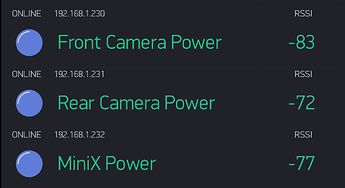Hi everyone!
I have a system with NodeMCU controlled by Blynk.
My code works correctly, but if I try to add code for OTA, my system disconnect and reconnect from wifi every 5/10 sec!
My system sends to Blynk data from my solar panel by INA219.
My system is not really close from router wifi, but without OTA code works correctly.
I have another NodeMCU to test, and instead of making the method that send solar panel data, I use a test method that send sum of number. If I stay near my router wifi, my test system works correctly and I can load new code by OTA. But If I walk away and I approach the area where I have the solar panel, NodeMcu disconnect and riconnect and I can’t load new code by OTA.
Why all this???
my code is this, thank you
#include <Blynk.h>
#include <ESP8266mDNS.h>
#include <WiFiUdp.h>
#include <ArduinoOTA.h>
#include <Wire.h>
#include <Adafruit_INA219.h>
#define BLYNK_PRINT Serial
#include <ESP8266WiFi.h>
#include <BlynkSimpleEsp8266.h>
char auth[] = "******";
//char auth[] = "*****"; // TOKEN DI PROVA
Adafruit_INA219 ina219;
char ssid[] = "ERRICIOFFI2.4";
char pass[] = "lunasissy";
//char ssid[] = "Linkem_0EC983";
//char pass[] = "bjig3vug";
//char ssid[] = "FERRIDEA";
//char pass[] = "possochiedere?";
float shuntvoltage = 0;
float busvoltage = 0;
float current_mA = 0;
float loadvoltage = 0;
float power_mW = 0;
float energy = 0;
float current_h = 0;
float current_day = 0;
unsigned long previousMillis = 0;
unsigned long interval = 100;
unsigned long currentMillis = 0;
#define relayFaretto10WD4 D4
#define relayMadonnaD5 D5
#define greenLEDD7 D7
#define redLEDD8 D8
#define buttonFaretto10W V0 // >> su D4
#define buttonMadonna V1 // >> su D5
#define timerFaretto V2
#define timerMadonna V3
#define correnteIstantanea V4
#define potenzaIstantanea V5
#define energiaTotale V6
#define correnteTotale V7
#define correnteTotaleDay V8
#define correnteTotaleDayGraph V9
boolean isFirstConnect = true;
boolean isConnesso;
boolean canSendCurrentDay = false;
BlynkTimer timer;
void setup(void) {
Serial.begin(115200);
Blynk.begin(auth, ssid, pass);
// Blynk.config(auth);
//Blynk.connectWiFi(ssid, pass);
ArduinoOTA.begin(); // For OTA
////////////////////////////////
ina219.begin();
pinMode(greenLEDD7, OUTPUT);
pinMode(redLEDD8, OUTPUT);
pinMode(relayFaretto10WD4, OUTPUT);
pinMode(relayMadonnaD5, OUTPUT);
digitalWrite(relayFaretto10WD4, LOW);
digitalWrite(relayMadonnaD5, LOW);
// Setup a function to be called every second
timer.setInterval(1000L, letturaPannelloProva); //// TEST METHOD
timer.setInterval(1500L, sendInaValues);
timer.setInterval(3000L, controllaConnessione);
}
void loop(void){
timer.run(); // Initiates BlynkTimer
ArduinoOTA.handle();
Blynk.run();
}
void letturaPannello() {
if(!isFirstConnect){
shuntvoltage = ina219.getShuntVoltage_mV();
busvoltage = ina219.getBusVoltage_V();
current_mA = (abs(ina219.getCurrent_mA())/1000);
power_mW = ina219.getPower_mW()/1000;
loadvoltage = busvoltage + (shuntvoltage / 1000);
current_h = (current_h + current_mA / 3600)/1000; // conteggio corrente totale
current_day = (current_day + current_mA / 3600)/1000; // conteggio corrente giornaliero
energy = (energy + loadvoltage * current_mA / 3600)/1000; // conteggio corrente energia
}
}
void controllaConnessione(){
if(Blynk.connected()){
digitalWrite(greenLEDD7, HIGH);
digitalWrite(redLEDD8, LOW);
isConnesso = true;
}else{
digitalWrite(greenLEDD7, LOW);
digitalWrite(redLEDD8, HIGH);
isConnesso = false;
Blynk.connect();
//Blynk.begin(auth, ssid, pass);
}
}
void sendInaValues(){
Blynk.virtualWrite(correnteIstantanea, current_mA); // V4
Blynk.virtualWrite(potenzaIstantanea, power_mW); // V5
Blynk.virtualWrite(energiaTotale, energy); // V6
Blynk.virtualWrite(correnteTotale, current_h); // V7
Blynk.virtualWrite(correnteTotaleDay, current_day); // V8
if(canSendCurrentDay){ // ALLO STOP DEL TIMER FARETTO
Blynk.virtualWrite(correnteTotaleDayGraph, current_day); // MANDO IL VALORE TOTALE DELLA CORRENTE PRODOTTA
current_day = 0;
canSendCurrentDay = false;
}
}
BLYNK_WRITE(buttonFaretto10W){ //controllo VIRTUAL Button Faretto V0 >> D4
if(param.asInt()==1){
digitalWrite(relayFaretto10WD4, HIGH); // START RELAY FARETTO
}else{
digitalWrite(relayFaretto10WD4, LOW); // STOP RELAY FARETTO
canSendCurrentDay = true;
}
}
BLYNK_WRITE(buttonMadonna){ //controllo VIRTUAL Button Madonna V1 >> D5
if(param.asInt()==1){
digitalWrite(relayMadonnaD5, HIGH); // START RELAY MADONNA
}else{
digitalWrite(relayMadonnaD5, LOW); // STOP RELAY MADONNA
}
}
BLYNK_WRITE(timerFaretto){ // timer V2 >>> buttonFaretto V0
if (param.asInt() == 1) {
Blynk.virtualWrite(buttonFaretto10W, 1); // button set to ON from timer
//digitalWrite(relayFaretto10WD4, HIGH);
}
else{
Blynk.virtualWrite(buttonFaretto10W, 0); // button set to OFF from timer
//digitalWrite(relayFaretto10WD4, LOW);
}
}
BLYNK_WRITE(timerMadonna){ // timer V3 >>> buttonFaretto V1
if (param.asInt() == 1) {
Blynk.virtualWrite(buttonMadonna, 1); // button set to ON from timer
//digitalWrite(relayMadonnaD5, HIGH);
}
else{
Blynk.virtualWrite(buttonMadonna, 0); // button set to OFF from timer
//digitalWrite(relayMadonnaD5, LOW);
}
}
////////////////// S Y N C ///////////////////////////////////
BLYNK_CONNECTED() {
if (isFirstConnect) {
Blynk.syncVirtual(energiaTotale); // V6
Blynk.syncVirtual(correnteTotale); // V7
Blynk.syncVirtual(correnteTotaleDay); // V8
isFirstConnect = false;
}
isConnesso = true;
}
BLYNK_WRITE(energiaTotale){
energy = param[0].asFloat();
}
BLYNK_WRITE(correnteTotale){
current_h = param[0].asFloat();
}
BLYNK_WRITE(correnteTotaleDay){
current_day = param[0].asFloat();
}
void stampaValori(){
Serial.print("Bus Voltage: "); Serial.print(busvoltage); Serial.println(" V");
Serial.print("Shunt Voltage: "); Serial.print(shuntvoltage); Serial.println(" mV");
Serial.print("Load Voltage: "); Serial.print(loadvoltage); Serial.println(" V");
Serial.print("Current: "); Serial.print(current_mA); Serial.println(" mA");
Serial.print("Power: "); Serial.print(power_mW); Serial.println(" mW");
Serial.print("Energia: "); Serial.print(energy); Serial.println(" mWh");
Serial.println("");
}
void letturaPannelloProva() {
if(!isFirstConnect){
shuntvoltage = ina219.getShuntVoltage_mV();
busvoltage = ina219.getBusVoltage_V();
current_mA = current_mA+0.5;
power_mW = power_mW+0.5;
loadvoltage = busvoltage + (shuntvoltage / 1000)+0.5;
current_h = current_h+0.5; // conteggio corrente totale
current_day = current_day + 0.5; // conteggio corrente giornaliero
energy = energy + 0.5; // conteggio corrente energia
}
}
